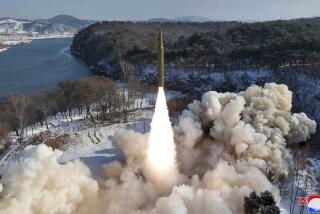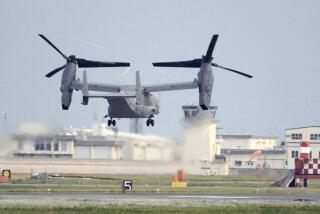South Korea finds two crashed drones, suspects North Korea
SEOUL -- South Korean officials were scrambling to explain how two drones, apparently from North Korea, entered the nation’s airspace, took photos of political and military sites and remained unnoticed until they were found crashed on the ground.
One of the unmanned aircraft was found March 24 in the city of Paju, close to the demilitarized zone that separates North and South Korea. The other was found Monday by a resident of Baengnyeong, a South Korean island in the Yellow Sea across from North Korea.
On the day the second drone was found, South and North Korea exchanged artillery fire after shells fired during a North Korean military drill landed in Yellow Sea waters claimed by the South.
South Korean officials described the drones as small and rudimentary and said they didn’t pose a serious military threat, though technically a chemical or biological weapon could be mounted on them.
One drone reportedly went down after running out of fuel, the other after an engine malfunction. South Korea had not confirmed they were from the North, but officials said it was a strong possibility.
Kim Min-seok, spokesman for South Korea’s Defense Ministry, said at a news briefing Thursday that fingerprints found on the drones didn’t match any from the country’s fingerprint database of all South Koreans. “We assume they belong to foreigners or North Koreans,” Kim said.
A battery inside one of the drones bore language commonly used in North Korea, officials said. Since the peninsula was divided in the 1950s, the versions of the Korean language spoken in the North and South have become different, with the South incorporating many words from English.
An unnamed military official told South Korea’s Yonhap News Agency that the drone found on Baengnyeong had been dispatched from Onchon Airport in South Pyongan province near North Korea’s western coast. The official said South Korean air force analysis of photos found in the drone’s memory card showed it had left the airport during North Korea’s military drills, then flown in a zigzag pattern above South Korea’s Yellow Sea islands before crashing.
South Korean media released photos believed to have been taken by the drones. The photos show the Blue House, South Korea’s presidential office, and military installations on Baengnyeong. The Defense Ministry said the drones were not equipped with real-time transmission functions, meaning that none of the photos could have made it back to North Korea.
It was unclear whether other drones had entered South Korean airspace. The Defense Ministry said the drone that crashed in Paju appeared to have made multiple flights, because its parachute had been folded and refolded several times. But there was no way to know if those flights were over South Korea.
Seoul is now under public pressure to strengthen surveillance of its airspace to prevent infiltration by drones or other aircraft. Local media reported this week that South Korean defense officials were considering acquiring low-altitude surveillance technology that could detect such small, low-flying drones.
The accord that ended combat in the 1950-53 Korean War requires both Koreas to refrain from encroaching on the opposite side of the demilitarized zone.
Nevertheless, Yonsei University professor John Delury said he expected the fallout from this incident to be limited, as there’s little the South can do beyond accusing the North of violating the terms of the accord.
“The South can’t really push this too far because there’s nowhere for them to take it,” Delury said. “This is just basic, crude intelligence-gathering. It’s nothing out of the ordinary.”
Borowiec is a special correspondent.
More to Read
Start your day right
Sign up for Essential California for news, features and recommendations from the L.A. Times and beyond in your inbox six days a week.
You may occasionally receive promotional content from the Los Angeles Times.






